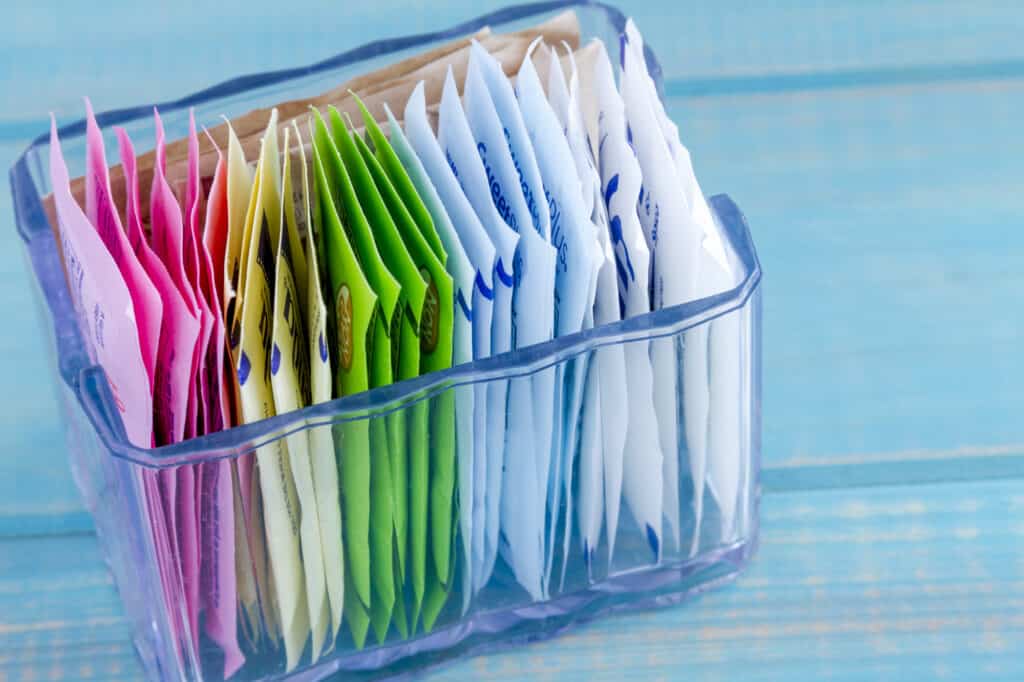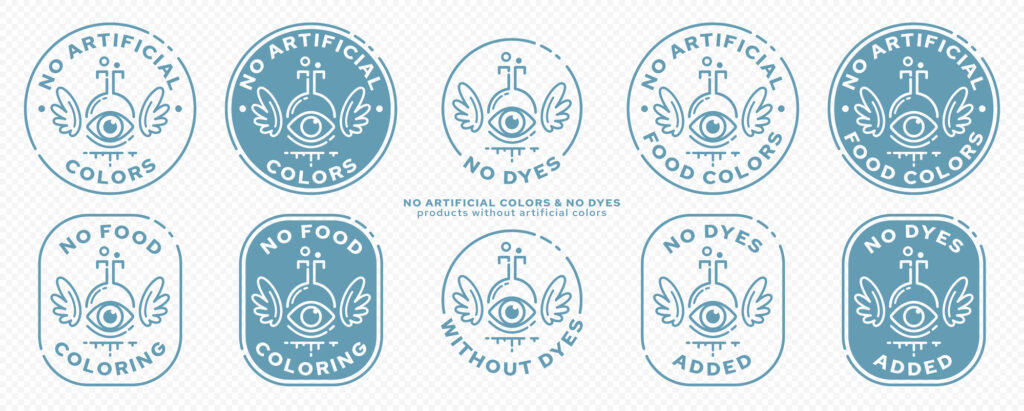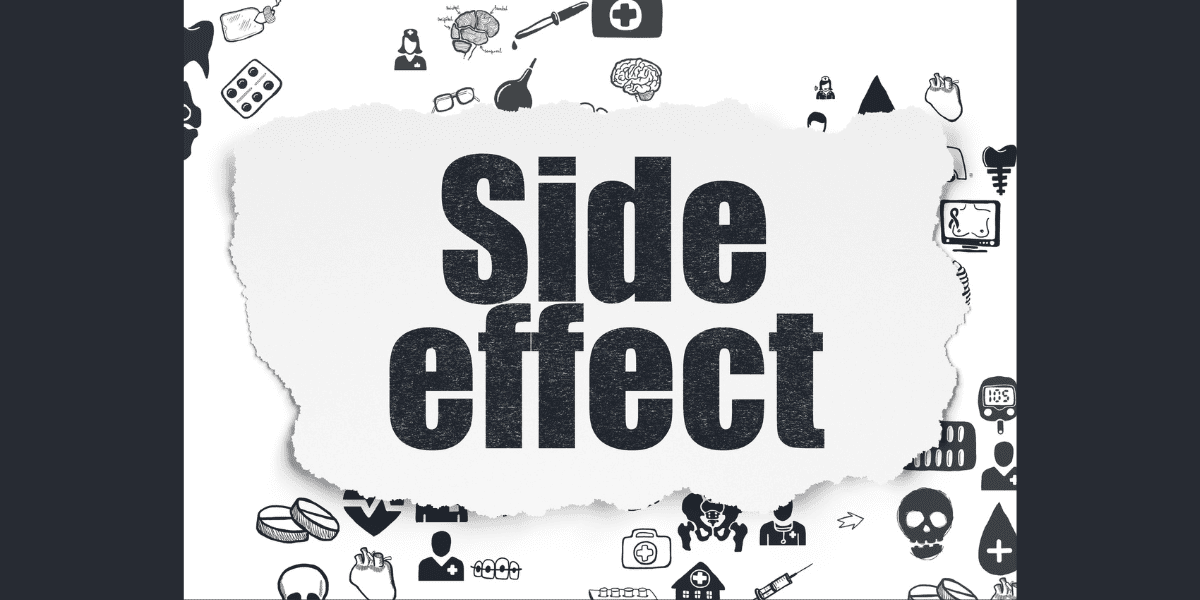EDITOR’S SUMMARY: “Side” effects. As in … not the main event. Like hors d’oeuvres or appetizers. No … better yet—a mere garnish, likened to a whimsical sprig of parsley laying on the side of your dish; certainly unworthy of your concern. This is the spell Big Food wants you to be under, and the narrative they need you to believe to keep making their big bucks. However, invisible as these effects and symptoms may be, particularly at first bite … they are far from insignificant.
*This article was updated on 11-21-25 (see below).
Written by Jennifer Wolff-Gillispie HWP, LC
Edited by Nicki Steinberger, Ph.D.
Surely the Food and Drug Administration (FDA) weeds out ingredients during their extensive testing protocols, that would be harmful to your health, right? But what if that’s not the case, and they don’t test at all? What! How can that be? Spoken by Jonathan Emord, Constitutional Attorney, in The Illusion of Democracy: Who Really Controls Our Lives:
“FDA never tests the drugs it approves; FDA does no independent testing at all. It relies entirely on the testing done by the proponent of the drug application that has a self-interest and conflict of interest. That party is looked at for all of the testing. It’s that degree of influence and corruption that makes it impossible for the American people to be protected.”
How often do you come across an ingredient listed on a “food” item that you have never heard of or can’t pronounce? You’ve likely wondered what it was, and if it was safe to consume. This article is an investigation of some of the most common ingredients that can be dangerous for you to ingest, and worth your vigilance when making decisions about what you put in your mouth.
Unlike whole food ingredients, such as strawberries, carrots, salmon, or beef, processed foods need ingredient labels to identify what they contain. When additives are listed on these labels, usually with long scientific names, there isn’t an accompanying dictionary to explain what they are, or what their purpose is. And there are no warning signs to point out the potential health risks they contain.
The World Health Organization’s (WHO) description of additives:
“Food additives are substances added to food to maintain or improve its safety, freshness, taste, texture, or appearance.”
The manufacturers of the additives maneuver within a regulatory loophole of the Food and Drug Administration (FDA), as they do not need to be tested in new products if they were previously determined “Generally Recognized As Safe” (GRAS):
“Under sections 201(s) and 409 of the Federal Food, Drug, and Cosmetic Act (the Act), any substance that is intentionally added to food is a food additive, that is subject to premarket review and approval by FDA, unless the substance is generally recognized, among qualified experts, as having been adequately shown to be safe under the conditions of its intended use, or unless the use of the substance is otherwise excepted from the definition of a food additive.”
Here are the most common categories of food additives:
- Preservatives (antimicrobials, nitrates and nitrites, antibrowning agents, antioxidants)
- Anti-caking agents
- Coloring agents (dyes)
- Flavoring agents (sweeteners, artificial sweeteners, flavor enhancers)
- Texturing agents (stabilizers, emulsifiers)
- Emulsifiers (partially hydrogenated, mono and diglycerides, trans fats, polysorbates)
Is It Any Wonder?
Preservatives are used to prevent food from spoiling and oxidizing. Historically, people used salt curing, dehydration, or smoking to achieve long-term preservation. Today, chemicals are added to achieve the same goal, without altering the original taste or texture of the product, but are linked to a myriad of health concerns. Take a look, and determine for yourself if there’s any mystery to why so many people in this culture do not feel good.
Benzoate (sodium benzoate, benzoate salt, benzoic acid, E211): Found in carbonated drinks, sauces, and margarines. Known to cause ADHD, negatively affects liver and kidney function, alters sperm mobility, sex hormones and reproductive organs. When combined with ascorbic acid (vitamin C), it can convert to benzene, a known carcinogen.
Bromates (potassium bromate, E924): Found in breads, bagels, and pastries. Increases risk of thyroid, kidney and other organ cancers, nausea, diarrhea, vomiting, kidney failure, bronchial conditions, and eye problems.
BHA and BHT (butylated hydroxyanisole and butylated hydroxytoluene): Found in lipsticks, moisturizers, and cosmetics. Carcinogenic, dysfunction in sex hormone production and abnormal sex organ development, endocrine disruptor, lung, eye and skin irritant.
Nitrates and nitrites (sodium nitrite—E249, potassium nitrite—E250) and nitrates (sodium nitrate—E251, potassium nitrate—E252): Found in cured and processed meats. Linked to renal cell carcinoma, breast, stomach, colorectal, esophageal and thyroid cancers.
Sulfites: Found in dried fruits, condiments, juices, and wine. Anaphylaxis, rapid heart rate, wheezing, hives, stomach problems, diarrhea, and difficulty swallowing.
Natamycin (E232): Found in cheeses, sausages, yogurts, and wine. Rashes, itching, hives, swelling in face/mouth, and tightness in chest.
Preservatives have also been linked to glucose intolerance and disruption in gut flora. In a joint study of researchers from Sheba Global and U.S. scientists from Harvard T.H. Chan School of Public Health, Brigham and Women’s Hospital in Boston, they were able to link a common food preservative (propionate) to the increased rates of obesity and diabetes in people worldwide.
They observed that when mice were fed the preservative, a chain reaction occurred leading to a spike in hormones that produced glucose. The results of the tests showed the mice gained weight and developed insulin resistance.
Insulin resistance is a core health problem in the U.S. and beyond, linked to a myriad of health conditions, including heart disease—the nation’s number uno killer. From WebMD, “Insulin Resistance”:
“Insulin resistance is when cells in your muscles, fat, and liver don’t respond well to insulin and can’t use glucose from your blood for energy. To make up for it, your pancreas makes more insulin. Over time, your blood sugar levels go up.”
And in Everyday Health, “What Is Insulin Resistance? Causes, Symptoms, Diagnosis, Treatment, and Prevention”:
“In the case of prediabetes, your pancreas works overtime to secrete enough insulin to regulate your blood sugar. But if your pancreas can’t keep up with the demand, insulin resistance can progress from prediabetes to type 2 diabetes. Most people diagnosed with prediabetes end up with type 2 diabetes within 10 years.”
Anti-caking agents are added to foods such as table salt, flour-based mixes, and spices, as well as nutritional supplements. Their purpose is to keep them from clumping or binding together, and allowing them to pour freely. Sometimes cellulose (made from wood pulp) is used to absorb excess moisture, but chemicals such as aluminum silicate, magnesium stearate, silicon dioxide, calcium silicate, iron ammonium citrate, and yellow prussiate of soda (sodium ferrocyanide decahydrate) are also used.
Although research is limited, linking the latter four ingredients as harmful if ingested,more testing is needed to determine this. Since silica is a naturally occurring element, it is believed to be safe. Aluminum silicate is of concern, however. From the Toxic Exposome Database:
“The main target organs of aluminum are the central nervous system and bone…Aluminum may induce neurobehavioral effects by affecting permeability of the blood-brain barrier, cholinergic activity, signal transduction pathways, lipid peroxidation, and impair neuronal glutamate nitric oxide-cyclic GMP pathway, as well as interfere with metabolism of essential trace elements because of similar coordination chemistries and consequent competitive interactions. It has been suggested that aluminum’s interaction with estrogen receptors increases the expression of estrogen-related genes and thereby contributes to the progression of breast cancer.”
Another category of ingredients that should rightfully raise an eye are food colorings. Plant derived colorants from fruits, vegetables, seeds, roots and spices are of little concern, but synthetic dyes derived from petroleum products absolutely are.

Nine synthetic dyes that are currently FDA-approved—a beautiful rainbow they are not:
- Blue 1 (Brilliant Blue)
- Blue 2 (Indigo Carmine)
- Blue 3 (Citrus)
- Red 2
- Green 3 (Fast Green FCF)
- Orange B (No longer used in the U.S., but was never officially banned)
- Red 3 (Erythrosine)
- Red 40 (Allura Red)
- Yellow 5 (Tartrazine)
- Yellow 6 (Sunset Yellow)
Blended to create vibrant, appealing colors in “fun” foods like chips, soda, ice cream, candies, crackers, cereals, and snacks, these dyes are undoubtedly marketed to children, but at what cost? Shockingly, all of the FDA-approved dyes are linked to disruptions in immune function, cancer/tumor growth, and hyperactivity/ADHD.
In fact, Dr. Leonardo Trasande, MD, MPP, FAAP, an AAP (American Academy of Pediatrics) Council on Environmental Health member stated:
“There are critical weaknesses in the current food additives regulatory process, which doesn’t do enough to ensure all chemicals added to foods are safe enough to be part of a family’s diet. As pediatricians, we’re especially concerned about significant gaps in data about the health effects of many of these chemicals on infants and children.”
More specifically, Office of Environmental Health Hazard Assessment Director, Lauren Zeise, gives the following warning:
“Evidence shows that synthetic food dyes are associated with adverse neurobehavioral outcomes in some children. With increasing numbers of U.S. children diagnosed with behavioral disorders, this assessment can inform efforts to protect children from exposures that may exacerbate behavioral problems.”
Another colorant used to create a brilliant white is titanium dioxide. Banned in Europe for concern over nanoparticle dangers, the FDA has recently stated, ‘“[t]he available safety studies do not demonstrate safety concerns connected to the use of titanium dioxide as a color additive.”’ This is in stark contrast to European Food Safety Authority (EFSA) Professor Maged Younes’ (expert on food additives and flavorings) take:
“Taking into account all available scientific studies and data, the Panel concluded that titanium dioxide can no longer be considered safe as a food additive. A critical element in reaching this conclusion is that we could not exclude genotoxicity concerns after consumption of titanium dioxide particles. After oral ingestion, the absorption of titanium dioxide particles is low, however they can accumulate in the body.”
The safety of these dyes are of so much concern even California lawmakers are pushing to remove them. Los Angeles Times, March 27, 2023: “So long, red dye No. 3? Why lawmakers want to cancel a chemical found in your Skittles and strawberry Yoohoo”:
“Assembly Bill 418, introduced by Jesse Gabriel (D-Encino) and Buffy Wicks (D-Oakland), seeks to prohibit red dye No. 3 for good along with brominated vegetable oil, titanium dioxide, propylparaben and potassium bromate.”
This bill passed the California State Assembly on May 15, 2023 and is awaiting ruling by the Senate Committees on Health and Environmental Quality. If passed, the ban will be effective starting January 1, 2025.

And Then the Sugar Replacements …
With increasing public awareness to the detrimental health impacts of type 2 diabetes, cardiovascular disease, and obesity, caused by consuming too much refined sugar, the need to find a suitable low-glycemic, non-blood sugar spike replacement has ensued. Sadly, most of the commercial alternatives are riddled with their own health risks:
Acesulfame potassium/ Ace-K (Sweet One, Sunett): Contains methylene chloride (carcinogen), and is linked to headaches, depression, nausea, liver and kidney disorders, metabolic syndrome, and premature birth.
Aspartame (NutraSweet, Equal): Converted to phenylalanine, aspartic acid and methanol in the body, causing disruption in brain chemistry and neurotransmitters. This has been shown to affect mood, cognitive ability, sleep, appetite, and cardiovascular health. It also increases cortisol, and negatively impacts gut microbiome.
But fear not, it’s still safe and acceptable, according to the International Agency for Research on Cancer (IARC) and the World Health Organization (WHO) and the Food and Agriculture Organization (FAO) Joint Expert Committee on Food Additives (JECFA), that is … if you keep your daily dosage to “40 mg/kg body weight.” So make sure you measure! Taken from the World Health Organization’s July 14, 2023 announcement, “Aspartame hazard and risk assessment results released”:
“The two bodies conducted independent but complementary reviews to assess the potential carcinogenic hazard and other health risks associated with aspartame consumption. This was the first time that IARC has evaluated aspartame and the third time for JECFA.
After reviewing the available scientific literature, both evaluations noted limitations in the available evidence for cancer (and other health effects).
IARC classified aspartame as possibly carcinogenic to humans (Group 2B) on the basis of limited evidence for cancer in humans (specifically, for hepatocellular carcinoma, which is a type of liver cancer). There was also limited evidence for cancer in experimental animals and limited evidence related to the possible mechanisms for causing cancer.”
*STORY UPDATE: 11-21-25
A new study published July 2025 in Scientific Reports found that aspartame interacts with and alters expression of several genes tied to vascular and inflammatory processes. The authors suggest that because these proteins manage inflammation and blood-vessel integrity, their disruption could potentially raise blood pressure and affect the brain-blood barrier, though further research is needed.
Saccharin (Sweet’N Low): Linked to type 2 diabetes, obesity, liver and kidney disfunction, and cancer.
Sucralose (Splenda): Greatly decreases beneficial gut flora, causing bloating and diarrhea, and studies have linked intake to migraines, altered glucose and insulin levels, as well as cancer. A new study from Journal of Toxicology and Environmental Health: Part B, Critical Reviews, “Toxicological and pharmacokinetic properties of sucralose-6-acetate and its parent sucralose: in vitro screening assays,” goes one step further explaining that sucralose is genotoxic, meaning it can break apart DNA in chromosomes causing cancer.
In yet another study in 2020 published in the journal, Cell Metabolism the Washington Post reported:
“… sucralose in combination with carbohydrates (like those in baked goods) can swiftly turn a healthy person into one with high blood sugar.”
The World Health Organization (WHO) seems to agree, recommending that artificial sweeteners like Splenda not be used to control weight, and that the “use of artificial sweeteners “does not confer any long-term benefit in reducing body fat in adults or children,” and “there may be … an increased risk of type 2 diabetes, cardiovascular diseases, and mortality in adults.”
Sugar alcohols (mannitol, sorbitol, erythritol, xylitol, lactitol, isomalt, maltitol, and (HSH) hydrogenated starch hydrolysates) are plant-based carbohydrates that are chemically-altered to taste sweet. They are linked to damage of beneficial gut bacteria causing bloating, gas, and gastrointestinal upset. They may also permanently alter your metabolism, and spike glucose levels leading to obesity, hormonal imbalance, and thyroid disruption.
Often used in low-carb and keto diets, sugar alcohols and alternative sweeteners allow you, i.e., give you “permission” to indulge in desserts and sweet snacks, gripping to your addiction, without high-glycemic sugars (carbs) that would kick you out of ketosis. Unfortunately, this “quick fix” solution caused by the need to replace junk food with lower-carb junk food has led researchers to determine that sugar alcohols are causing liver cancer.
In relation to sugar alcohols and related health injury, Professor Andras Perl, M.D., Ph.D had this to say in “Upstate study links ingredient in sweeteners to liver cancer”:
“We should avoid using sugar alcohols, such as erythritol and sorbitol, as sweeteners.” explains Perl. Erythritol is added to many sugar substitutes, such as Truvia and other stevia/monkfruit/keto reduced-sugar products. Sorbitol is used to sweeten products like chewing gum, ice cream, and mints.
The FDA classifies erythritol as “generally recognized as safe” because it is a naturally occurring compound, but the quantities used in foods are generally much higher than is typically created by the body. “Normally the level in the body is very low, undetectable” Perl said:
“It’s causing liver cancer, there’s no doubt,” said Perl, about sugar alcohols. He describes studying cancer cells in vitro. “When we treat cancer cells with sweeteners, it causes the proliferation of cancer cells; they grow much more rapidly. In contrast, when we treat cancer cells with inhibitors of aldose reductase, it blocks their proliferation.”
Even “natural sweeteners” such as monk fruit and stevia may be of concern. Many popular brands are mixed with sugar alcohols or low-quality ingredients, which are not evident at first glance on the packaging. Diligent label reading is paramount to ensure you are purchasing a pure form.
Another point with stevia is that it may be genetically-modified. From Organic Consumers Association, “Buyer Beware: GMO Stevia Is Everywhere”:
“Genetically engineered (GE) versions of stevia have received the green light for widespread and unregulated use in food, including Cargill’s “nonartificial stevia,” a GE-derived synthetic biology product designed to mimic components of the real thing. Meanwhile, the U.S. Food and Drug Administration (FDA) has labeled stevia leaf and crude stevia extracts “unsafe food additives.”
Flavor enhancers are added to foods to boost flavor and appeal. You may be familiar with MSG (monosodium glutamate), and other additives including sodium aspartate, disodium inosinate (IMP), disodium guanylate (GMP), disodium cytidylate (CMP), disodium adenylate (AMP), disodium uridylate (UMP), and disodium succinate may also be used. This is a small sampling of the many chemically-derived concoctions concealed in the processed food industry.
According to AdditiveFreeKids, common side effects from these ingredients include migraines, asthma, fatigue, depression, insomnia, shakes, dehydration, brain fog, headaches, nausea, dizziness, numbness, heart palpitations and skin irritation. Shockingly, this isn’t the worst of it. They assert:
“It is a proven fact that MSG and other flavour enhancers are highly addictive. After eating this toxic chemical your taste buds are left craving more and more. As you crave more of the foods containing flavour enhancers all other food begins to taste bland by comparison and you lose the joy of real food. Not only is it highly addictive, it is also known to cause obesity. Numerous researchers around the world are using MSG as a tool to create obese rats and mice to carry out research on.”
Texturizing agents are added to foods to alter and enhance the thickness, creaminess, chewiness, or overall “mouth-feel” of the product. Gelatin (animal protein from animals), pectin (fruit), agar (algae), carrageenan (seaweed), xanthan gum (fermented sugar and bacteria), and guar gum (guar beans) are naturally-cultivated from plant and animal sources.
“Natural” is not enough: All natural texturizing agents, especially in excessive amounts, are linked to disruptions in the gastrointestinal tract (GI) including gas, bloating, diarrhea and blockages. Xanthan gum, although made from natural sources, is still considered synthetic, as it is lab-created and not naturally-occurring. Additionally, xanthan gum has the potential to cause allergies and extreme lowering of blood pressure.
Gelatin is mainly created from the by-products of the industrial farming industry—animals who were likely fed genetically-modified foods, with a high probability of injections from antibiotics, veterinary drugs, and hormones. There is also emerging evidence that some texturizing agents can be teratogenic (cause fetal abnormality).
Carrageenan, derived from red seaweed, is an ingredient with a lot of controversy. There are two types of carrageenan available—food-grade and non-food-grade (degraded). The food-grade version is the only one allowed by the FDA as an additive. However, take a look at this: From MedicineNet, “What Is Wrong with Carrageenan?”
“Degraded carrageenan, also known as poligeenan, is a proven carcinogen (cancer-causing substance) and, hence, is not approved for use in foods. For long, poligeenan has been used to induce inflammation in animals for research purposes. But researchers have found poligeenan labeled as carrageenan in some products. In some of them, it was as much as 25 percent.”
And just try to find a nutritional supplement without magnesium stearate (the magnesium salt of stearic acid) in the list of “other ingredients.” Oh sure, you can find it eventually, but you’ll be digging through multiple bottles and containers to get there. Also called vegetable stearate, it’s an emulsifier used in food and supplement production, not to be confused with magnesium forms your body needs. Known as being one of the most prevalent ingredients in vitamin and supplement manufacturing, this ingredient has been linked to poor intestinal absorption, suppression of T-cell production, and risk of formaldehyde exposure.
Get your fats right: Effective in 2020, the FDA banned the use of partially-hydrogenated fats in “most” processed foods. Associated with raising your LDL (low-density lipoprotein) cholesterol levels and increasing your risk of heart disease, stroke, and type 2 diabetes, trans fats have no place in your food supply, but there’s a sneaky way you may be ingesting them.
Mono and diglycerides contain small amounts of trans fats, but since they are used as emulsifiers, or as other agents in foods, the FDA ban does not apply. You will find them labeled as monoglycerides, monoacylglycerols, or glycerolipids. Recently one company, Apeel Technologies, developed a coating using mono/diglycerides to prevent spoilage on fruits and vegetables, and claims the coating cannot be washed off.
Polysorbates are another example of emulsifying agents used in food, personal care products, medications, and vaccinations. There are many different names they go by—polysorbate 20, PEG, polyethylene glycol, Tween 20, and sorbitan laurate are some of the most common. They are linked to cancer, reproductive dangers, developmental problems and allergies.

Your Kitchen Is Your Best Bet
As you reflect on the large assortment of additives, sweeteners, dyes, and emulsifiers, etc., you’ll notice these ingredients are typically found in highly-processed foods, packaged in boxes, cans, and bags, as well as prepared in hot food bars. One way to avoid them entirely is to purchase whole food ingredients yourself, and prepare them in the comfort of your own kitchen (or a best friend’s, family member’s, or community center).
Preserved meats like sausage or lunch meat can be swapped with homemade fresh cuts, and seasoned with herbs and spices. Rice, pasta, breads, cakes, and even chips, crackers, and candies can be prepared from scratch using the same philosophy—sourcing high-quality, preservative-free ingredients, and choosing a colorful array of organic spices to create great taste.
Consider seeking out new recipes that mimic your go-to processed favorites, and freeze large batches of foods, such as breads, cookie dough, soups, and entire meals, so that you always have something healthy and additive-free on hand. Baking or frying up chips and crackers can actually be fun, and less time-consuming than you might think.
If you don’t have the wherewithal or desire to cook mainly from scratch, be a conscientious label reader, and choose foods that have the capacity to elevate the way you feel, rather than take you down, and create life-threatening health issues.
Start a new tradition in your home, and consider including others on meal prep day. Children are receptive to change when they are a part of the process and solution. Giving the gift of health through safe and nourishing food is an undeniable offering with potential for long-term wellness.
~
Published on July 20, 2023.
If you’d like to contact A Voice For Choice Advocacy, please email media@avoiceforchoice.org.
If you would like to support the research and health education of AVFC editorial, consider making a donation today.

